The HTC 10 Review
by Joshua Ho on September 19, 2016 8:00 AM ESTBattery Life
Battery life is still one of the most important aspects of any mobile device, and as a result our testing of a mobile device needs to properly emphasize this aspect. As a result, it’s important that every device is tested in the same manner to avoid bias in one way or another. In order to achieve this, all devices have all possible background services disabled, as well as sync and automatic app updates. In order to try and make an even comparison we also set the display to 200 nits brightness on a 100% average picture level display, also known as a blank white screen. However, one area that we aren’t necessarily able to control for 100% of the time is ambient temperature, device orientation, or material contact. While tests that don’t reach TDP limits won’t see any effects, TDP-limited tests will see a delta here, but it’s hard to estimate just how much of an impact exists here. While we might be able to do some power characterization, in most cases review units are not allowed to be torn down and with a general decrease in the number of devices with removable batteries power characterization has to be done through the fuel gauge which is often unreliable. With the HTC 10, this fuel gauge is only updated every minute so there’s realistically no way to actually test power outside of full rundown tests.

In our first test we can see that the Galaxy S7 is actually slightly down on power efficiency relative to the HTC 10. I went back and ran the HTC 10 on our basically display-bound battery life test and the Galaxy S7 gets around 12.34 hours while the HTC 10 gets 11.63 hours. That’s about a 5-6% delta which is almost entirely down to display efficiency, so I suspect that the difference here is actually due to optimizations in DVFS and other optimizations that would probably fall under the “PowerBiotics” branding that HTC seems to be using here.
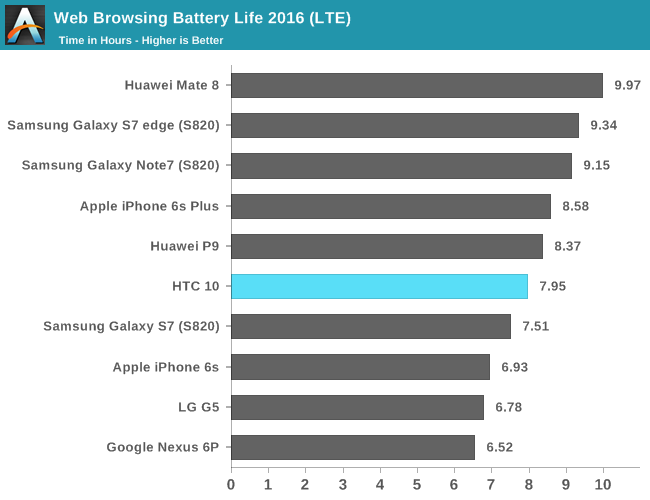
Moving on to the LTE version of this test we can see that HTC has really done an amazing job of implementing their cellular solution as battery life is basically identical to what it is on WiFi. It’s likely that poor reception conditions will tilt the scales back towards WiFi but in areas of good reception the HTC 10 has relatively good battery life on LTE. This is probably compounded by the fact that the HTC 10’s LTE reception is actually significantly above anything else I’ve used in recent memory including the LG G5 and Galaxy S7.
In the interest of trying to see whether this sort of pattern holds across the board, PCMark is another test that emphasizes power consumption but rather than just web browsing it attempts to have a mix of CPU and GPU usage in general purpose tasks as well as some general purpose IP blocks like video decode. While a relatively small part of overall power consumption, storage power consumption is also a part of the test as things like the photo editing subtest will involve reading and writing to non-volatile storage.
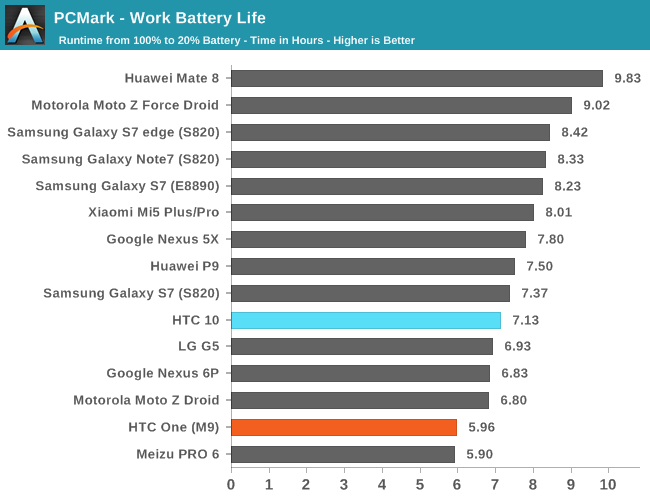
Interestingly enough, the HTC 10 ends up being slightly behind the Galaxy S7 here. Again, it’s likely that we’re looking at the difference in display power here as the Galaxy S7’s 1440p AMOLED display has a lower subpixel density and in a few tests the average picture level is relatively low. HTC is also using an ever so slightly larger display which would tilt the scales as well. Of course, none of this really changes the fact that display-bound workloads are going to see the HTC 10 performing worse than the Galaxy S7, but from an academic perspective it’s interesting to keep tabs on how AMOLED and LCD compare in terms of efficiency. It goes without saying that the Galaxy S7 edge with its huge battery easily pulls away from the HTC 10 and pretty much anything on the market but if you want a phone usable with one hand I would argue that the Galaxy S7 edge isn’t really a one-handed phone.
Moving on to the sustained rundown tests we can take a look at how an OEM has chosen to optimize their thermal management strategies, which often vary from device to device despite similar SoC and design. While we used to run Basemark OS II and GFXBench for this part of the test due to the arguably misleading results that Basemark OS II provides we’ve dropped it entirely to improve the signal to noise ratio of our reviews.
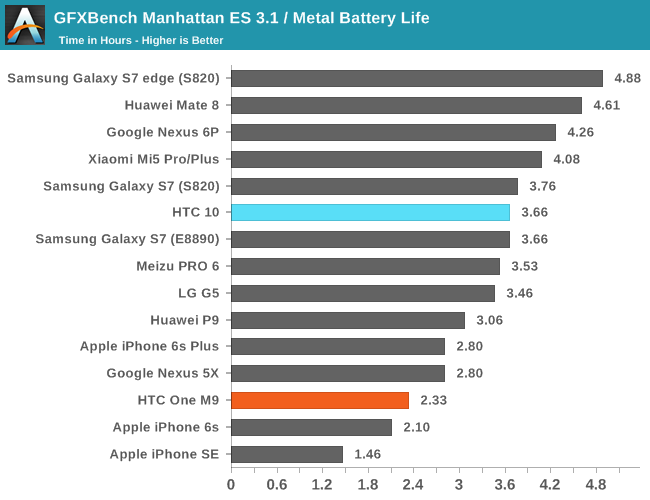
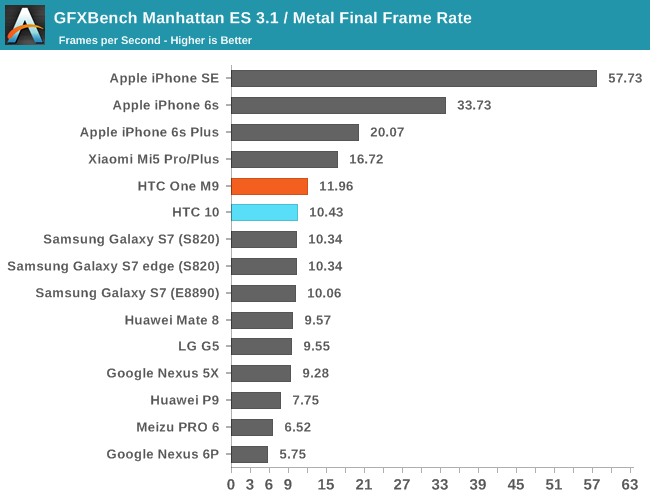
In GFXBench’s Manhattan ES 3.1 infinite rundown again we’re seeing the differences that come from display efficiency deltas but the difference is so small because SoC is pretty much the dominating factor when a display of this size will consume about a watt and the TDP-limited power consumption of the SoC is about two watts. What is noteworthy here is that HTC tends to do a better job of throttling the SoC such that the degradation is graceful. Samsung and LG both seem to favor maximizing short term performance which results in underdamped behavior which actually has a pretty appreciable impact on things like VR performance although given that no OEM is shipping Daydream-ready devices yet it isn’t necessarily critical for an OEM to be getting throttling right.
Overall, HTC does manages to pull in fairly respectable battery life despite being down on display efficiency. Our new tests manage to highlight the surprising level of optimization that HTC has put into the 10, but in use cases where you can’t really optimize things like cellular connectivity or governor behavior the HTC 10 slightly trails the Galaxy S7. When compared against something like the Galaxy S7 Exynos 8890 variants the HTC 10 is going to trail in anything CPU-bound as Kryo is just not as efficient as Exynos M1 for whatever reason. I don’t really think it’s a fair comparison but the Galaxy S7 edge is undoubtedly a big step up in battery life relative to the HTC 10, but this comparison only makes sense if you are willing to deal with the larger 5.5 inch display.
While I hate using screen-on time as a metric for battery life, generally speaking where the One M7 got about 3-4 hours of constant use when new the HTC 10 seems to achieve about 6 hours of use or so which is much more than what the 30% bump in battery capacity would suggest, especially once you factor in the half inch difference in display size, so the efficiency benefits of newer SoCs like the Snapdragon 820 are absolutely noticeable.
Charge Time
While battery life is probably the single most important metric of a mobile device, it’s important to not forget that these devices still need to spend at least some time wired up, whether directly in the form of an AC adapter or indirectly by swapping batteries. As a result it’s important to see how quickly the device’s battery will charge as generally speaking end users don’t hotswap batteries and charging the phone’s battery with an AC adapter is the dominant use case where charge time matters. To test this we use a number of methods, but for this review we will rely on measurements from the wall and using the time it takes for the device to drop to a certain level of power draw from the wall to indicate a full charge state, which is generally quite close to the time it takes for the device itself to indicate 100% but may take longer depending upon how an OEM adjusts battery state of charge determination and presentation.

It turns out that the HTC 10 charges fairly quickly, but it’s not necessarily as fast as what something with QC 2.0. This might seem counter-intuitive but realistically it’s not supposed to be faster than QC 2.0, but to reduce battery and device heating to better preserve the battery over time. Regardless, pretty much anything that charges in under 2 hours is going to be fairly comparable here. The Galaxy S7 does charge faster, but at the cost of overall battery lifetime. The LG G5 is actually slightly slower to charge here, so all things considered the HTC 10 is doing pretty well here. The one notable winner here is the OnePlus 3, which seems to charge quickly with relatively low battery heat due to its proprietary Dash Charge system.


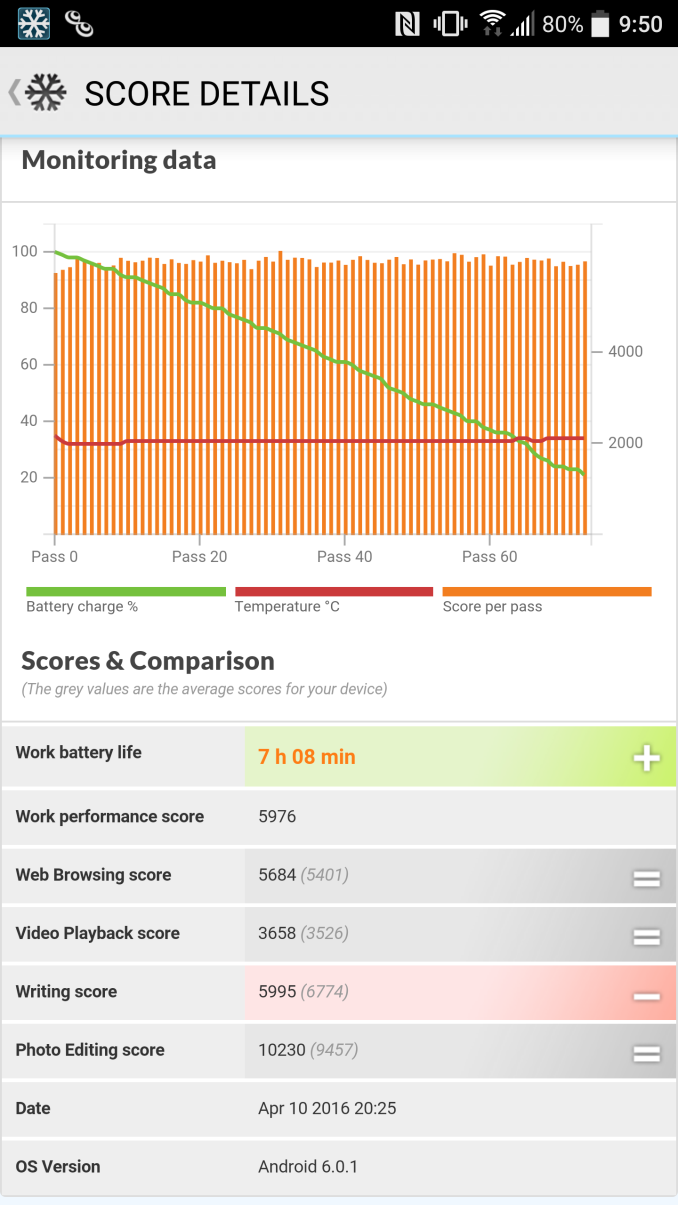
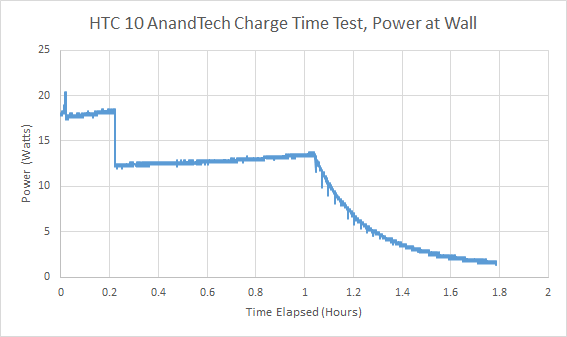








183 Comments
View All Comments
edlee - Wednesday, September 21, 2016 - link
i loved my m8, nothing i got recently feels as good as that phone did.Since that phone, i have had s6, and s7 edge, but for some reason m8 will always stick with me
bennyadamo - Thursday, October 6, 2016 - link
Agreed. The One M8 was a smartphone masterpiece. I owned both the M8 and a Galaxy S5 (and numerous iphones) and in terms of design, performance and user interface you still can't beat the M8. And HTC's Sense UI absolutely blows iOS and "Touchwiz" out of the water (just an aside, but how idiotic is "touchwiz" as a name for a UI? Or for anything else for that matter? I feel embarrassed just typing it). If you think the UI doesn't make a huge difference in your phone experience, try using Sense and Touchwiz side-by-side for a week. Even just small things like the small amount of lag time it takes for the display to re-orient from portrait to landscape when rotating the phone in your hand become infuriating when you have to live with Touchwiz daily. And besides the superior UI, the One M8 just looked and felt like a premium piece of hardware. Many, many times I had people ask me what type of phone it was or inspect it front to back when I let them hold it in their hands, impressed by the solid/premium feel of it. At this point, the One M8 is still (rather unfortunately) HTC's high-water mark. Although having said that I did just order the HTC 10 to take advantage of their sale ($150 off if you buy an unlocked phone directly from HTC from 10/1/16 to 10/8/16).Also, I read some of these comments saying that it's a waste of time to review or buy a phone 7 months after it's launch - that's not true and is a really misguided/misinformed opinion. A lot of people buy a phone that long after it's come out simply because they are waiting for their current phone contract to expire. Other reasons are because some of the teething bugs have been worked out or simply because the price drops after that amount of time (read above re: HTC's current sale on the HTC 10). The average person doesn't need to buy the newest/highest-end/highest-spec phone every year, and most people probably get 2-2.5 years out of a smartphone like this.
ipaulw83 - Monday, September 19, 2016 - link
certainly not dead, the HTC 10 is a far much better choice than the G5, S7 & Note 7 "Fiasco" and other flagships. the only real threat to HTC is the OnePlus 3 but overall the build quality and camera is in favor of HTC 10... i would hate to see them die or break software updates promises as recent news, nevertheless they have a great product that is more special than any other current android flagship (IMHO).i do not own any HTC product currently or stock or anything i use an iphone and an LG nexus 5x but wanted to give my opinion
repatch - Monday, September 19, 2016 - link
"far much better choice" for you perhaps. Why all the generalizing?I for one went with the LG G5, for one reason: the camera. The super wide angle camera on this thing is FANTASTIC, everyone who's seen it marvels at the kind of shots you get with it. It's REALLY fun. For ME, the "far much better choice" is the G5, but that won't apply to most others.
The S7 for me was a no go due to the glass back (can't stand glass backs because they are so prone to breakage, my Nexus 4 went through 3, and NONE of those were broken due to drops). The HTC 10 just didn't have anything 'special' going for it.
Again, that's MY opinion, it's best to sit down and write down what are go/no go's, for YOU, and make a choice that way.
IMHO of course.
Impulses - Thursday, September 22, 2016 - link
I really wanted to like LG's latest, I use an ultra wide lens on my mirrorless M4/3 cameras so that was right up my alley... The overall package (and uber gimmicky modules on their latest) never convinced me.If I HAD picked up a new phone last year it would've been a 10, for the better audio and lack of TouchWiz... My N5 is still trucking along tho, at least until the Pixels come out.
This breadth of choices, even in a market that's contacting, is still something I really like about the Android ecosystem.
FourEyedGeek - Monday, September 19, 2016 - link
Already have the Galaxy S7...smorebuds - Monday, September 19, 2016 - link
And this article is for you and only you...FourEyedGeek - Tuesday, September 20, 2016 - link
Its for all those people who want to make a decision on buying a new smartphone, but might have been helpful to those making a choice months ago don't you think?Freido - Monday, September 19, 2016 - link
HTC 10 is a nice looking phone. But it lacks a high brightness screen. It is a tad bigger as well. Thats my personal opinion. If it was a bit smaller like 4.9", I would have bought it. I've decided to buy Sony X compact or iPhone SE. Recent Sony phones like xlX performance and XZ sports very good displays I think. Looks as stunning as of iphones IPS displays.I was wondering why Anandtech never reviews Sony flagships even though they does release good phones with less gimmicks.
Will anyone consider my suggestion?
fanofanand - Monday, September 19, 2016 - link
They have addressed this in the past, typically Sony does not give out samples to the press. In today's "give me everything for free" world, websites like this simply don't have the excess cash to go buying every cool new toy that comes out. Would it be sweet? Absolutely, but for the most part if Anandtech doesn't review something it's because they couldn't obtain one from the company.